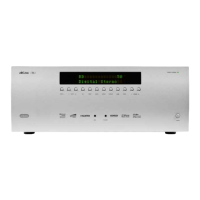13
The post-DAC lters comprise 4 low noise NJM2068 dual op amps, running from the +/- 7V supplies.
One op amp is assigned to each channel and performs the dual functions of converting a dierential
input from the DAC to a single ended output, whilst simultaneously functioning as a three pole 50kHz
active lter.
The AM/FM tuner module’s outputs pass through the inductors L310 and L302 (providing 19kHz notch
and 38 kHz low pass ltering) and the shunt mute circuits formed by the 330R resistors R354/R369 and
the two halves of Q306 plus Q307.
IC101 has a xed level stereo output for Zone 2 (SUB_L and SUB_R) and a second one, adjustable from
0dB to -18dB in 6dB steps, for the AVR360’s analogue to digital converter (ADC_L and ADC_R).
IC101 has one 8 channel variable level output bus labelled VOL01 through to VOL08. Capacitors C295-8
and C231-4 oat the ground ends of the associated internal potentiometers to minimize clicks This bus
goes via specially selected 100μF/25V capacitors to the dual op amps IC121-124, wired as voltage follow-
ers and running from the +/- 15V supplies. The C, SL, SR, SBL and SBR outputs are shunt muted when
required via the 560R resistors R383-388 and the dual transistors Q303-305.
The subwoofer output SW has two shunt mute circuits. One using Q311 works in parallel with the rest of
the channels. The other, using Q308 and half of Q303 allows muting of the SW channel alone.
The FL and FR channels take o the stereo headphones amplier feed from IC121 (it goes via the con-
nector WF101 to the Front Panel Board), then add an extra dual voltage follower IC125 and a double
pole shunt mute switch using 4 x 270R resistors and Q301-302. All the above ICs are JRC NJM2068s or
equivalent.
All 8 of these outputs go to via the connector WF103 to the preamplier output sockets and (except for
the subwoofer output) to the 7 power amplier inputs located on the Main Board.
The ADC input ampliers use a JRC NJM2068 for each channel, operating as a single-ended input to
dierential output converter, with HF ltering above about 400kHz. This is sμFcient for anti-aliasing
purposes as the analogue modulator of the ADC samples at 6.144 MHz and only needs to keep out
frequencies above 6MHz.
The array of 12 switching transistors in the bottom right hand corner of the schematic is arranged in
4 blocks of 3 devices (two npn and one pnp per block). The array is used to control the muting of 4
specic groups of audio outputs, taking into account the presence of AC mains via P_U (the pull up line
from the Power Supply board) and the MUTE_POWER line derived from the power ampliers’ Vcc rail
– this is normally high when Vcc is high. The output lines are SB_MUTE2 (for the surround back chan-
nels SBL and SBR), ZONE2_MUTE2, HP_MUTE2 (for the headphones relay on the Front Panel board) and
FUNC_MUTE2 (for the 6 main audio channels excluding SBL and SBR).
Zone 2 volume is independently adjustable in 1dB steps via IC131 (rohm BD3812F). Its outputs are
buered and amplied 15dB by the dual op amp IC132 and can be muted when required by Q402. The
output goes directly to two phono sockets forming half of JK11 on the back panel.
SPDIF inputs, ADCs, DACs and Audio DSPs
The AVR360 has 4 coaxial 75 ohm SPDIF (Sony/Philips Digital InterFace) inputs and 2 TOSLINK optical
inputs on its back panel. A further optical input is located on the front panel as part of JK92 (this socket
also includes the AUX and MIC inputs). There are 6 further external SPDIF inputs - one per HDMI input
socket and one on the HDMI output socket (the Audio Return Channel or ARC).

